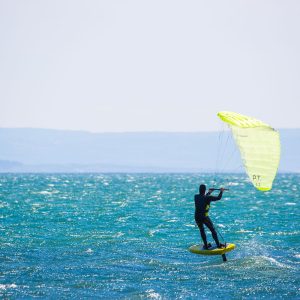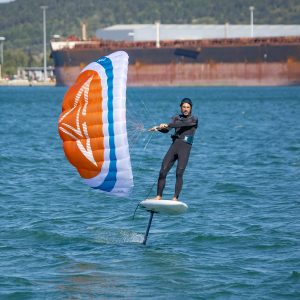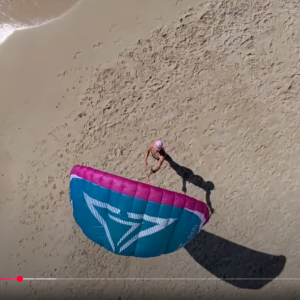
As with any parawing, we advise practicing ground handling with the P.T. first. This will help you familiarize yourself with the canopy’s movements, making your start on the water much easier. Choose a location with consistent wind, free of obstacles that could create turbulence. Move the P.T. from side to side to get a feel for how the bar input affects the canopy’s response.
Once you feel confident on the ground, you can move to the water. If you are using the P.T. with a skateboard or skis, this is also the time to begin practicing movement.
On the water, it is important to start within the upper wind range rather than the lower range. This reduces the effort needed from your legs to lift the foil and allows you to focus on the angle and position of the P.T.
The board should have at least +30L buoyancy over the rider’s weight.
Choose a spot with onshore or side-shore wind and minimal waves—the calmer, the better. This reduces unnecessary interference, making it easier to start. It is common to drift downwind during takeoff attempts, so selecting a location with easy access back to your starting point is essential.
If you have good wind access, you can enter the water with the canopy already inflated. If launching from the lee side, you may need to swim out with the board and the packed P.T. Once in position, hold the P.T. by the leading edge, lifting it to inflate. Ideally, you will catch it mid-air and have it flying immediately. If not, the air inside the canopy will keep it afloat, allowing you to inflate it from the water.
Once inflated and settled, sit on the board with the P.T. positioned directly overhead to minimize its pull and reduce downwind drift. When you’re ready, pull the back part of the bar slightly and lean the P.T. slightly to the side where you want to start. As the board accelerates, stand up.
When standing up, continue to build speed and adjust your legs into the correct position before takeoff. In this phase, it is crucial to build speed gradually, avoiding excessive or overly aggressive pumping of the P.T. Unlike a wing, a parawing needs to generate apparent wind to produce lift. Aggressive pumping, as used with a wing, does not work with a parawing—it can cause it to lose its shape and, consequently, its lift force.
For a proper takeoff, gradually build speed with the board. As your speed increases, adjust your heading to generate even more speed. At this point, start gently pumping the board with your legs while making minimal inputs to the parawing. The key is to pump the board using the lower part of your body, from the hips down, so that your movements do not overly affect the parawing.
Once you have reached takeoff speed, gently pull up and continue pumping while staying low to build even more speed. In this phase, the P.T. will rapidly generate lift and become more stable and responsive to bar inputs.
We recommend using a harness loop line from the beginning of your learning process. It reduces strain on your body, allowing you to focus solely on steering with the bar rather than holding the propulsion forces. This will significantly extend your time on the water and accelerate your learning process.
The sooner the board moves, the easier it will be to maintain balance. With longer, downwind-oriented boards, start at least 20 degrees downwind from a side-wind position, as they can be difficult to maneuver once in motion. Shorter boards are more maneuverable.
If the wind is strong enough, you should start moving with a slight pump of both the wing and board. In lighter wind conditions, a stronger and well-synchronized pump is necessary to achieve takeoff. This may take some practice to perfect.





